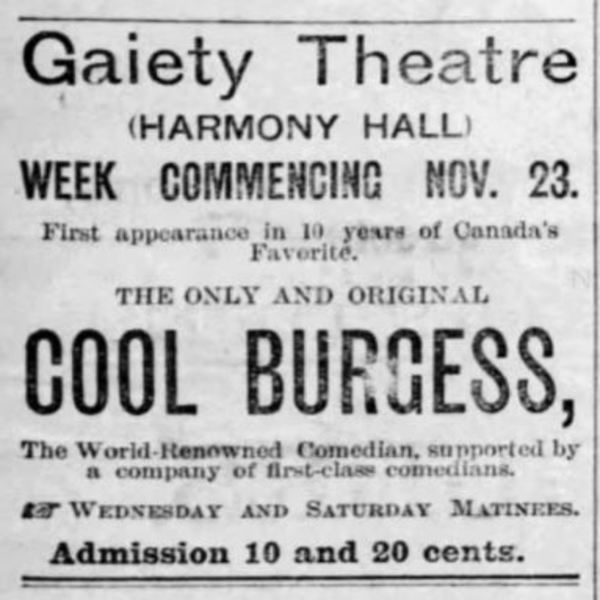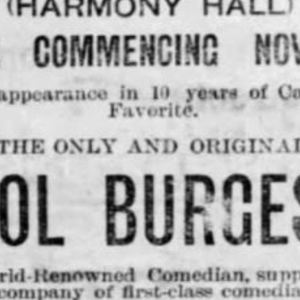
Source: Link
BURGESS, COLIN (Cool), minstrel and theatrical manager; b. 20 Dec. 1840 in Yorkville (Toronto), youngest son of Colin Burgess (d. 1842) and E. Marten; m. 19 May 1862 Edna Stephenson Taylor in Toronto, and they had three sons and two daughters; d. there 20 Oct. 1905.
Ironically, Colin Burgess was born in the year the black community of Toronto first petitioned against the caricatured depiction of blacks on stage and in circuses. His early years at the grammar school on Bloor Street run by the Reverend John George Delhoste MacKenzie* and at the Yorkville public school were, in Burgess’s words, “not very eventful.” His musical talents were noted, however, and it must have been fun living in the Rising Sun hotel, built by his Scottish-born father on Yonge Street, south of the toll-gate at Bloor. Leaving school at 15, he was apprenticed to Clark Brothers, a carriage-making firm, where he would train for three years as a painter.
But minstrelsy – America’s first indigenous form of entertainment – called. Colin frequented St Lawrence Hall when visiting troupes played, and with his friends he put together makeshift minstrel concerts in barns and saloons, where he honed his comic gifts, clacked the bones (ebony sticks), and sang. By February 1857 he had blacked his face to sing at Toronto’s Royal Lyceum Theatre in the chorus of Uncle Tom’s cabin, in which American-born Denman Thompson played Uncle Tom and Charlotte Nickinson was Eliza. Burgess credited the Lyceum’s printer, Alexander Jacques, later his advance-agent, with first applying the burnt cork to his face professionally and encouraging him to take up minstrelsy as a vocation. In April 1858 Burgess, Patrick Redmond, and Thompson opened a concert hall on Adelaide Street East with a two-night minstrel show. For these performances Colin changed his name to Cool, sang, delivered a comic monologue on “Woman’s rights,” and played the character of Bones in the comic afterpiece A ghost! In spite of himself. In December 1858 he celebrated his 18th birthday at the Royal Lyceum as part of Burgess and Redmond’s Ethiopian Star Troupe, probably his first touring company, and he returned there a year later with Cool Burgess’s Chicago Minstrels. For the next 30 years his name would be front and centre on the playbills of North America.
Burgess’s big break came in 1862 when Duprez and Green’s minstrels, an American group, played Toronto and needed a comic end-man on short notice. Cool was recommended and hired at $50 a week. Throughout the 1860s and 1870s he led and toured with a succession of leading American companies. In Canada he tended to put together his own troupes such as the Trans Atlantic Company, which featured Scottish, English, and Dutch entertainers brought to Canada after Cool’s highly successful visit to Britain in 1873. While touring in 1867 he had discovered George Henry Primrose, a bellboy at the Tecumseh House in London, Ont., and pointed “the infant clog dancer” to fame as Canada’s second great minstrel performer. In 1877 Cool’s was the first professional company to visit Winnipeg.
The tripartite form of minstrel shows varied little in the early years. In the first part, which began and ended with a rousing musical dance number, Burgess was always featured as Brother Bones, because of the instrument he played. He sat at one end of the semi-circular chorus opposite his comedic counterpart, Brudder Tambo (on the tambourine). In the centre was the white-faced Mr Interlocutor, who served as master of ceremonies and the butt of a rapid exchange of wheezes, puns, riddles, and malapropisms, all punctuated with slaps on the tambourine or runs on the bones. In 1875 a Toronto columnist reported that Burgess’s “stock of witticisms seems to be inexhaustible.” The second section of the show, the olio, was a grab-bag of variety acts, and the concluding part a plantation drama or farcical burlesque.
Interspersed among the exchanges were sentimental and silly songs. As early as 1873 Burgess was combining “whiteface songs with darkey characters.” Much of the parlour sheet music of the era came from minstrel shows. At least three songs performed by Burgess were published in Toronto in the 1870s and collections came out in New York in 1877 and around 1880. An obituary would describe his “Shoo, fly! Don’t bodder me!” as “the most popular ‘coon’ song of its decade.”
Remembered for his bluff, forceful personality and boisterous laugh, Burgess developed a repertoire of hilarious and often original specialty numbers. In “Nicodemus Johnson,” his most “irresistibly funny” routine, his blacked-up character wore three-foot-long shoes and made the dust fly as he welted the floor and pranced exhaustingly. New York newspapers assured their readers that Burgess had not only introduced the blackface monologue – a questionable claim – but had been the first “long-shoe” dancer.
After the emancipation of slaves in the United States, blacks were finally allowed to perform and they gravitated to the minstrel show, creating their own all-coloured companies and more authentic depictions of plantation life. In response, white minstrelsy began to change during the 1870s and 1880s. Lavish new production values moved it towards musical revue and the second part of the show began to be separated out. Burgess shone in the olio and the titles of his shows, such as “Olio of oddities” (Kingston, Ont., 1871) and “Carnival of novelties” (Ottawa, 1872), reflected the new direction. Theatre historian Gerald Lenton-Young postulates that the name of Burgess’s Gaiete Vaudeville Company, which operated in Ontario in 1871, contains one of the earliest recorded uses of the word vaudeville. Later in the same year Burgess appeared in New York with Antonio Pastor, the man generally acknowledged to be the originator of this form of entertainment. Like him, Burgess had a reputation for a clean variety show, with nothing “that would offend good taste.” Although Burgess continued to appear with notable minstrel troupes, from the mid 1870s he became more and more associated with variety and early attempts at vaudeville. In his last regular year of performing, 1890, he was on the Brotherhood Combination Vaudeville bill in the Bowery district of New York with a featherweight boxer and a dog act.
In 1866 Burgess had been hailed in the Toronto Daily Telegraph as the “champion of Ethiopian delineators . . . his name alone is sufficient to draw a good house.” The New York Morning Telegraph commented at his death that he had got his nickname, Cool, not only by abbreviating Colin but by handling his business affairs with aplomb. At his height he was once given a contract paying him $300 a week whether he worked or not. He, never accepted a smaller amount and was the first minstrel to command such a salary when others of comparable rank were getting only $40. There is a story of his carriage arriving at a theatre in Philadelphia and the tall and lanky minstrel with the drooping moustache refusing to dismount until he was paid in full before the performance. Such payment was to become one of his customary business stipulations.
In 1885 Burgess tried his hand at running a hotel in New York, in addition to performing, but by 1891 he had retired to Toronto, where he had always maintained a residence and where his children were educated. A final performance is recorded at Tony Pastor’s 14th Street Theatre in New York in 1899. About 1901 Burgess moved to a small farm on Eglinton Avenue. In 1905, after a lingering bout of dropsy, he died of heart failure at Toronto General Hospital. Theatre-goers in New York and Toronto mourned the passing of the “idol of the minstrel world” and “the prince of burnt-cork comedians.”
Listings for the sheet music for three songs performed by Cool Burgess, issued in Toronto during the 1870s, appear in Canadiana, 1867–1900. Two songbooks (consisting of the lyrics only) published in New York, Cool Burgess’ Oh! Don’t get weary children songster; containing the latest collection of the most popular songs of the day . . . (1877) and Cool Burgess’ I’ll be gay songster; containing a fine collection of this great artist’s best songs, as sung by him in all the principal theatres of the United States and Canada ([1880?]) are listed in the National union catalog; copies of both are available at the New York Public Library.
A playbill for the Burgess and Redmond show “Fun for the million,” Toronto, 19 April 1858, is preserved at the MTRL and is reproduced in Early stages: theatre in Ontario, 1800–1914, ed. Ann Saddlemyer (Toronto, 1990), 179. Advertisements and reviews of his shows appear in the Toronto Globe, 1854–90, and Leader, 1854–78; Ottawa Citizen, 1871–98; Manitoba Free Press, July–August 1877; London Free Press, 2 Jan. 1888; and Hamilton Herald (Hamilton, Ont.), 8 June 1901.
The MTRL also holds a copy of Cool Burgess, 1840–1905 (Toronto, 1905), a pamphlet containing reprints of several obituaries, notably two articles by John Ross Robertson* from the Toronto Evening Telegram, 20 and 21 Oct. 1905, and the tribute in the New York Morning Telegraph, 22 Oct. 1905.
AO, RG 8, I-6-B, 66: 152. Mount Pleasant Cemetery (Toronto), Tombstone inscription. NA, RG 31, C1, 1871, Toronto, St David’s Ward: 37; 1891, Toronto, St Patrick’s Ward: 28 (mfm. at AO). Boston Herald, 10 Dec. 1911. Globe, 21 Oct. 1905: 6. D. [G.] Hill, “Blacks in Canada: a forgotten history,” Toronto Star, 17 Feb. 1979: C4; “Trial and triumph: black progress in young Toronto,” Globe and Mail, 11 Dec. 1976: 10. New York Times, 21 Oct. 1905: 7. Toronto Daily Star, 20 Oct. 1905: 1. World (Toronto), 21 Oct. 1905: 8. M. M. Brown and Natalie Rewa, “Ottawa calendar of performance in the 1870s,” Theatre Hist. in Canada (Toronto and Kingston, Ont.), 4 (1983): 134–91. Directory, Toronto, 1871/72–1900. M. D. Edwards, A stage in our past, English-language theatre in eastern Canada from the 1790s to 1914 ([Toronto], 1968). Franklin Graham, Histrionic Montreal; annals of the Montreal stage . . . (2nd ed., Montreal, 1902; repr. New York and London, 1969). G. H. Ham, Reminiscences of a raconteur between the ’40s and the ’20s (Toronto, 1921), 175–76. Carolyn Hetherington, “An olio of oddities,” Kingston 300: a social snapshot, by Kingstonians (Kingston, 1973), 185. M. B. Leavitt, Fifty years in the theatrical management (New York, 1912). Gerald Lenton-Young, “Variety theatre,” Early stages: theatre in Ontario, 1800–1914, 166–213. New York Dramatic Mirror, 28 Oct. 1905: 16. G. C. D. Odell, Annals of the New York stage (15v., New York, 1927–49), esp. 8–13. The Oxford companion to Canadian theatre, ed. Eugene Benson and L. W. Conolly (Toronto, 1989). 66. Robertson’s landmarks of Toronto, 1: 490. M. C. Shortt, “From Douglas to The Black crook: a history of Toronto theatre, 1809–1874” (ma thesis, Univ. of Toronto, 1977), 106, 147, 177. M. E. Smith, Too soon the curtain fell: a history of theatre in Saint John, 1789–1900 (Fredericton, 1981), 108, 147. R. C. Toll, Blacking up: the minstrel show in nineteenth century America (New York, 1974), 286.
Cite This Article
David Gardner, “BURGESS, COLIN (Cool),” in Dictionary of Canadian Biography, vol. 13, University of Toronto/Université Laval, 2003–, accessed December 29, 2025, https://www.biographi.ca/en/bio/burgess_colin_13E.html.
The citation above shows the format for footnotes and endnotes according to the Chicago manual of style (16th edition). Information to be used in other citation formats:
| Permalink: | https://www.biographi.ca/en/bio/burgess_colin_13E.html |
| Author of Article: | David Gardner |
| Title of Article: | BURGESS, COLIN (Cool) |
| Publication Name: | Dictionary of Canadian Biography, vol. 13 |
| Publisher: | University of Toronto/Université Laval |
| Year of publication: | 1994 |
| Year of revision: | 1994 |
| Access Date: | December 29, 2025 |



